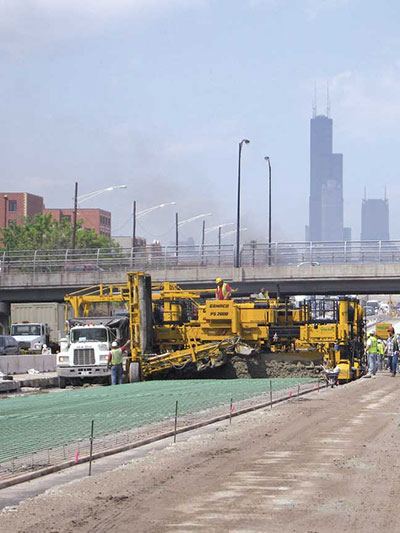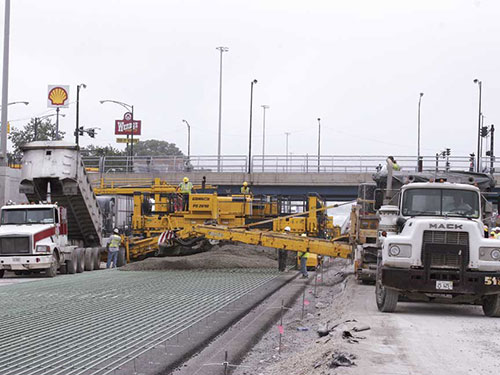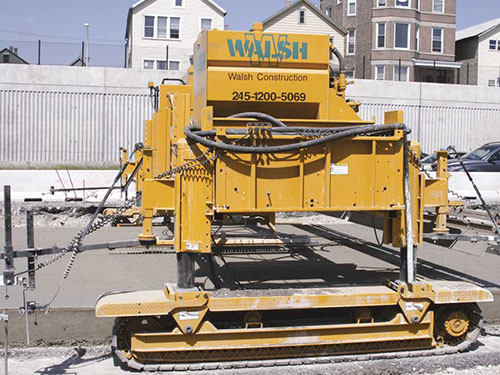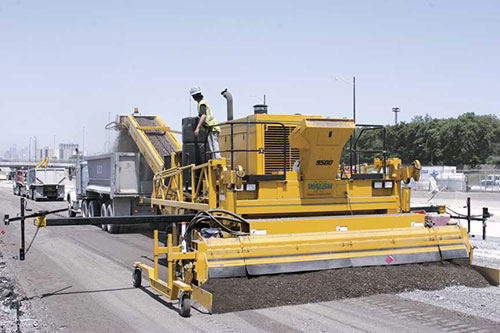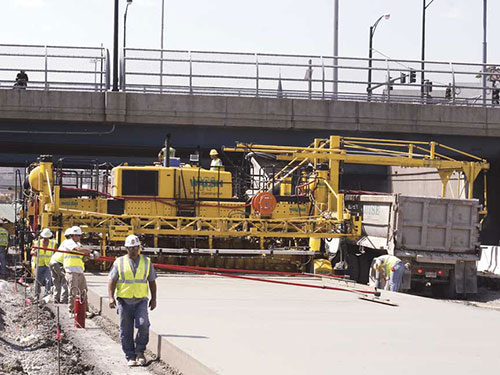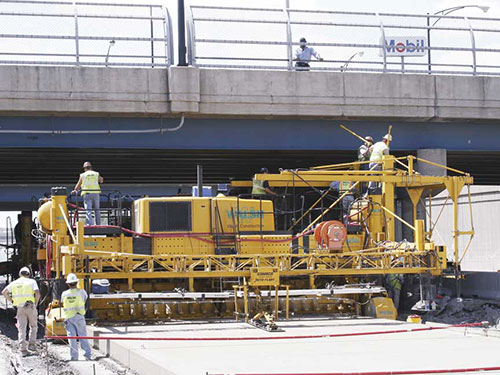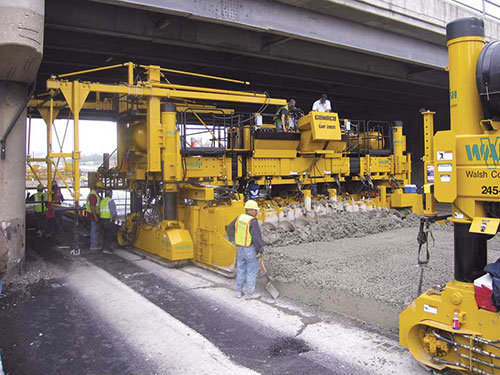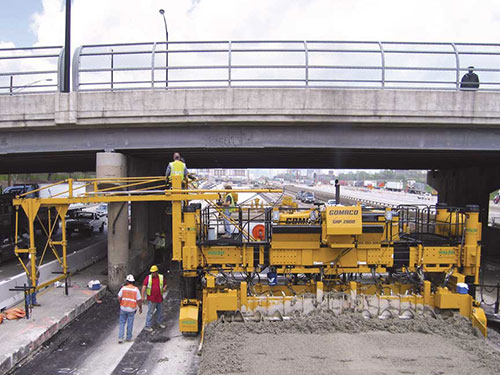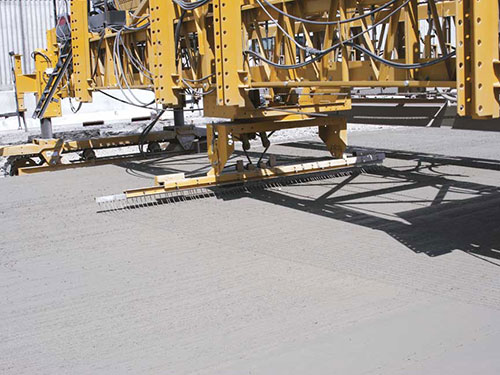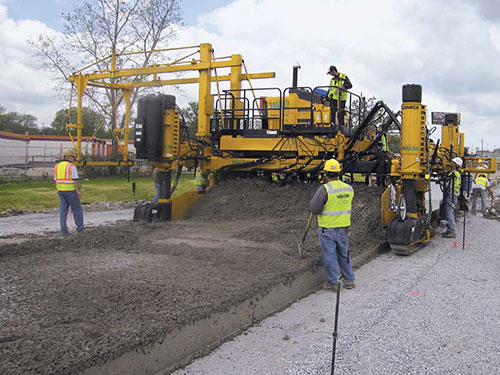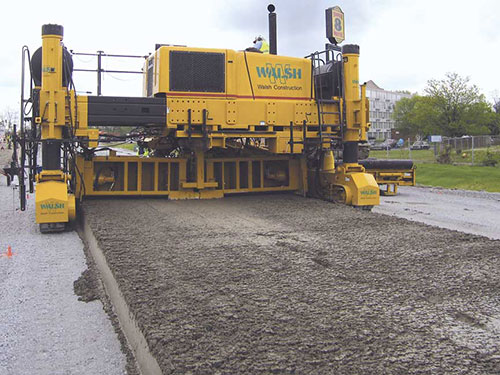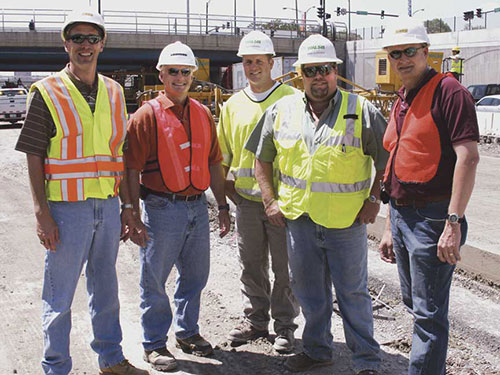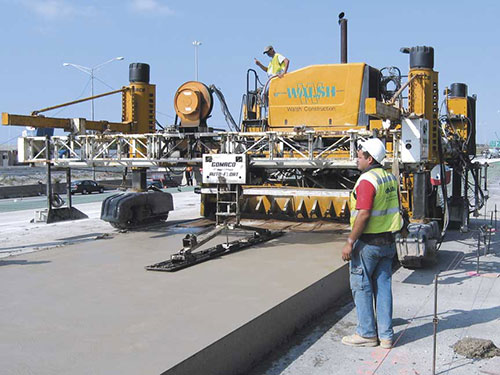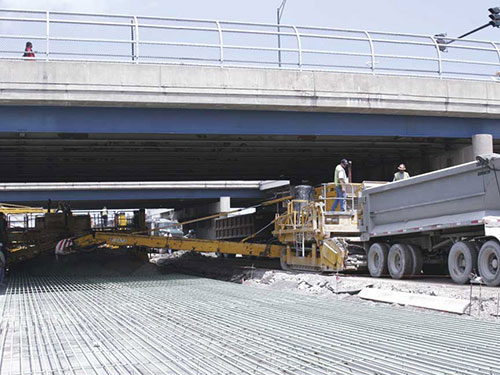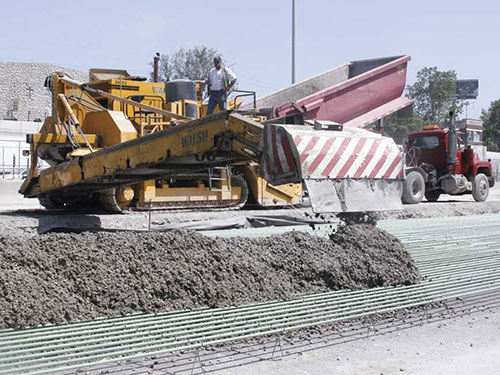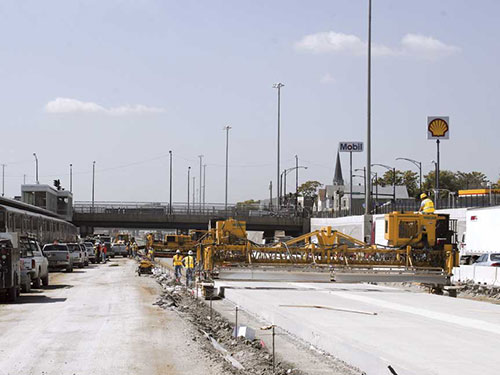GOMACO World Index --- GOMACO World 34.2 - October 2006
Paving The Dan Ryan Expressway
Traffic is brutal. Trucks of various models and sizes idle as they wait their chance to pass. A commuter train races by as people concentrate on the task at hand. All of this is happening within the confines of the job site... a job site located right in the middle of the Dan Ryan Expressway through the heart of downtown Chicago, Illinois.
The Dan Ryan was originally constructed from 1961 to 1963, and was designed for a lifetime of 20 years. At the time, it carried an average of 150,000 vehicles per day. Today, 43 years since the original construction was completed, the Dan Ryan carries over 300,000 vehicles per day, far exceeding its life expectancy and carrying capacity. The Illinois Department of Transportation (I-DOT) decided it was time to rebuild their busiest expressway through the Chicago area.
Walsh Construction Company, based out of Chicago, has been at work on the Dan Ryan Expressway for the last two years getting perimeter walls in place and paving entrance and exit ramps. This year they were awarded the contract to pave six miles (9.7 km) of express lanes in each direction, four lanes wide. They have six months to remove and replace the 48 lane-miles (77 km), for a total of 400,000 square yards (334,440 m2) of concrete pavement on the project.
Job-site logistics are a nightmare. The express lanes are on the inside lanes of the freeway, so Walsh is surrounded on both sides by three lanes of traffic still carrying 100,000 vehicles per day during reconstruction. Commuter train stations and train tracks crisscross through the project. On any given day, there’s over 100 trucks traveling inside the project area, and just getting concrete to the paving site requires careful coordination and timing.
The project and its figures are enormous and a challenge that Walsh Construction thrives on. Walsh is a nationwide company, and in the Chicago area alone, has over one million square yards (836,100 m2) of concrete paving on projects for toll roads, expressways, ramps and airport work. They need paving equipment with high-production rates and excellent smoothness results for Illinois’ zero-blanking band requirements. In the last two years, Walsh Construction has increased their paving equipment inventory by 40 percent, including the purchase of several new pieces of GOMACO paving equipment. Many pieces of the new GOMACO equipment are at work on the Dan Ryan Expressway.
The Dan Ryan is being built for durability and longevity. It has been designed to last a lifetime of 30 years, starting with the subgrade. The first layer is a geo-fabric liner to prevent moisture from seeping up from the ground and causing cracking through the subgrade layers and the concrete expressway itself. On top of the geo-fabric is 21 inches (533 mm) of recycled concrete with another three inch (76 mm) layer of smaller-sized recycled concrete and asphalt grindings.
A GOMACO 9500 trims the grade on the project and dumps the excess material into waiting semitrucks with trailers.
“The 9500 is the ticket as far as trimming goes,” Rocky Bellis, General Superintendent for the Chicago Heavy Highway Division of Walsh Construction, said. “I would put a 9500 single lane trimmer against a dual-lane trimmer any day of the week and you’d put out just as much. The 9500 is a great piece of equipment.”
The two layers of recycled concrete are topped off with a final six inches (152 mm) of bituminous base course binder. The final step is slipforming a 14 inch (356 mm) thick pavement over continuous reinforced concrete (CRC) on top of the 30 inches (762 mm) of subgrade layers.
“This is a 100 percent dump truck job with a central mix plant,” Bellis explained. “We’re placing concrete over the CRC with either a GOMACO PS-2600 placer/spreader or a 9500. We’re running the 9500 up in front because it seems to secure the mat of rebar before the PS-2600 belt placer comes along. The PS-2600 caps, strikes off, and levels the concrete before the paver hits it.
“We have a concrete delivery rate of 400 cubic yards (306 m3) per hour. The 9500 is placing approximately 150 cubic yards (115 m3) per hour. Following behind it, the PS-2600 belt placer is dropping approximately 250 cubic yards (191 m3) an hour through it.”
There are 20 different bridge structures that Walsh has to pave under on the project. Clearances underneath the bridges are too low for dump trucks to be able to lift and dump their load on the belt of the PS-2600. It’s where the maneuverability of the 9500 and its 35 foot (10.7 m) long placing conveyor are crucial.
Dump trucks can back up to the bridge structure and dump their load of concrete into the hopper of the 9500. The operator of the 9500 can then use the long placing belt to get concrete in front of the paver, underneath the bridge. Also, with a hopper full of concrete, the 9500’s operator can easily maneuver it in the tight conditions underneath a bridge to place the concrete exactly where it needs to be. The height limitations caused by dump trucks are easily overcome with the versatility of the 9500.
A two-track GHP-2800 paver follows behind the placers slipforming the new lane of expressway 14 inches (356 mm) thick and 24 feet (7.3 m) wide. Extra features on Walsh’s paver include a hydraulic gantry kit and an Auto-Float® with misting bar.
“We’ve become accustomed to the gantry kit and we really like it,” Bellis said. “It keeps the stringline away from the trucks, we don’t have to worry about our finishers bumping the line, and we don’t have to build our haul roads out quite as far.
“On this job, with the 20 different bridges that we have to get under in each direction, we lose our capacity to run stringline because the piers are so tight. What we’ve been doing is, once we get up to the bridge, we hydraulically retract the gantry kit, lock the paver in on cross slope, run it through, and then hydraulically push the gantry back out. It slows us down a bit, but versus the cost of steel forms and trying to hand pour two lanes of CRC, there’s no comparison.”
Walsh’s two-track paver is working well for them to achieve ride results on the state of Illinois required zero-blanking band specification.
“We’ve been consistently getting a good ride with our two-track GOMACO pavers,” Bellis said. “Historically, we’ve been making our numbers consistently, no matter what job it is. The two-tracks have been working tremendously for us. In tight areas like this, where we have to jump a lot of bridges, move around in traffic, and jump a lot of obstructions, the two-track we can just put on a low boy without any breakdown and move right on down the road. It’s that simple... easy to break down, set up and we get our quality rides.”
Following behind the GHP-2800 paver is a GOMACO T/C-600 texture/cure machine with the new skewed tining option. The state of Illinois requires skewed tining on all of their projects. The Dan Ryan’s tight project conditions required a tining innovation that could be mounted underneath the machine and not create any additional length, otherwise the haul roads would be cut off.
“GOMACO engineered a design for our texture/cure machine where the tine rake is on a gear drive,” Bellis explained. “As the tine rake travels back and forth, it skews on the frame without the frame actually having to be skewed. It draws the rake forward and it draws it back on a 6:1 skew and it’s all dialed in by a chain gear. It’s worked great.” (See the technical article in this issue.)
Walsh also has their four-track Commander III, with a gantry system, at work on the project paving ramps, single lane pours and exterior shoulders.
“We have steel in the single lane and we’re slipforming over hundreds of drainage structures in the shoulder. We’re presetting them, slipforming over the top, and it’s working out fine. The state is liking the project,” Bellis said. “The gantry kit on the single lane paving has improved our production from about 140 cubic yards (107 m3) an hour to 190 cubic yards (145 m3).
“The Commander III is a dynamite machine. It’s versatile and can push a load of concrete. It works great.”
The entire Dan Ryan Expressway project won’t be completed until 2007. I-DOT still has to let the local traffic lanes and Walsh Construction is hoping to get that portion of the project as well. In the mean time, they’ll finish up their work on the express lanes and other projects around Chicago.
Nationwide, Walsh Construction is growing and expanding. They currently have four million square yards (3,344,400 m2) of concrete paving to complete.
A project included in that figure is the reconstruction of Interstate 74 through downtown Peoria, Illinois. The project involves the removal and replacement of eight miles (12.9 km) of the roadway. I-74 carries more than 60,000 vehicles daily and two major hospitals are located along its route. It’s a challenging project for Walsh. They’re currently at work on the westbound lanes which will be completed by November of this year.
Walsh completed the first half of the project, the eastbound lanes, last year, and this summer an open house was held to celebrate the project’s successful start. The event was co-sponsored by the Illinois Chapter of the American Concrete Pavement Association (ACPA), Illinois Ready Mixed Concrete Association, I-DOT, ACPA national, and the Concrete Reinforcing Steel Institute.
“I-74 runs right through the middle of Peoria and it has its difficulties,” Bellis said. “We have approximately 300,000 square yards (250,830 m2) of continually reinforced pavement on a stabilized asphalt bituminous base that we have to pave on a tight schedule and under several bridges so we can complete the project by November.”
Brad Barkema, GOMACO’s North Central District Manager; Andy Bazan, Finkbiner Equipment; Jamie Vidito, Walsh’s Project Superintendent; Rocky Bellis, Walsh’s General Superintendent for the Chicago Heavy Highway Division; and Kent Godbersen, GOMACO’s Vice-President of Worldwide Sales and Marketing; inspect the Dan Ryan Expressway project in Chicago.
They have the GOMACO paving equipment and knowledgeable personnel to make the Peoria project, and all of their projects nationwide, a success. A close working relationship with GOMACO and our GOMACO distributor in the Chicago area, Finkbiner Equipment Company, has also been beneficial for everyone.
“We work with Finkbiner in this area and they have an excellent team of mechanics and give us great support,” Bellis said. “That shows through with GOMACO, too. Their service and parts departments are phenomenal. They take care of us and that comes right from the top with GOMACO.”
The 9500, with its long belt, places concrete in front of the PS-2600 underneath a bridge structure on the Expressway.
Subscribe to Receive GOMACO World Magazine
